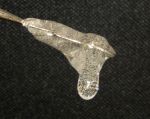EPJ E - Too cool to follow the law
- Details
- Published on 10 August 2012

Study suggests viscous materials do not follow standard laws below a sub-melting point threshold.
So-called glass-formers are a class of highly viscous liquid materials that have the consistency of honey and turn into brittle glass once cooled to sufficiently low temperatures. Zhen Chen and his colleagues from Arizona State University, USA, have elucidated the behaviour of these materials as they are on the verge of turning into glass in an article just published in EPJE.
Although scientists do not yet thoroughly understand their behaviour when approaching the glassy state, this new study, which relies on an additional type of dynamic measurements, clearly shows that they do not behave like more simple fluids, referred to as “activated” fluids. This is contrary to recent reports.
Typically, the dynamics of materials are described using a formula called the Arrhenius law, which is well known for chemical reaction rates. It states that a very simple law regulates how temperature affects characteristics such as viscosity and relaxation times –i.e., delay in returning to equilibrium after the material has been subjected to a perturbation.
The authors used a so-called "residuals" analysis to show that Arrhenius type dynamics is not a common behaviour at temperatures between a sub-melting point threshold, called the crossover temperature, which occurs at a dynamic transition point, and the glass transition temperature, where the liquid becomes a glassy solid.
Zhen Chen and co-authors came to this conclusion by analysing not only the material’s viscosity but also more precise data on the dielectric relaxation time available within the same temperature range. This gave them a more exact account of relaxation dynamic properties in highly viscous materials.
The study revealed the need for greater precision in the viscosity data of glass-former materials to avoid masking its actual behaviour from data treatment and graphical representation.
On the dynamics of liquids in their viscous regime approaching the glass transition. Z. Chen et al., Eur. Phys. J. E (2012), DOI 10.1140/epje/i2012-12065-2




